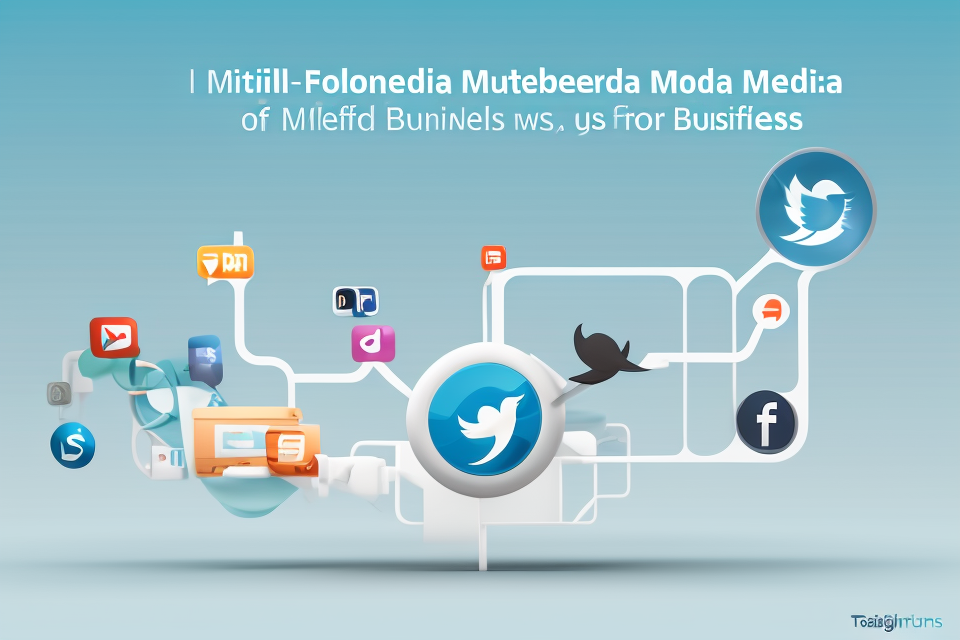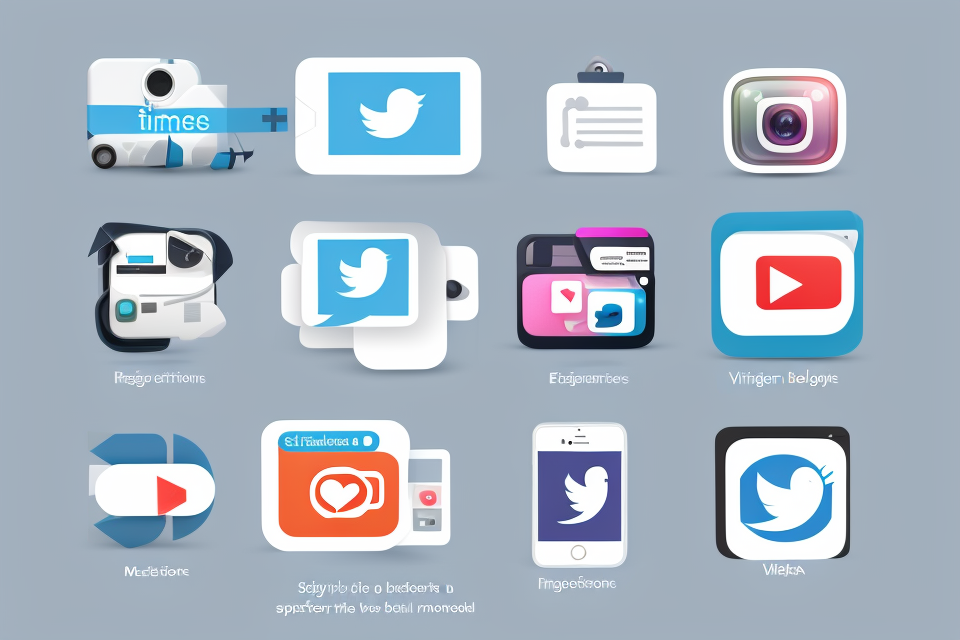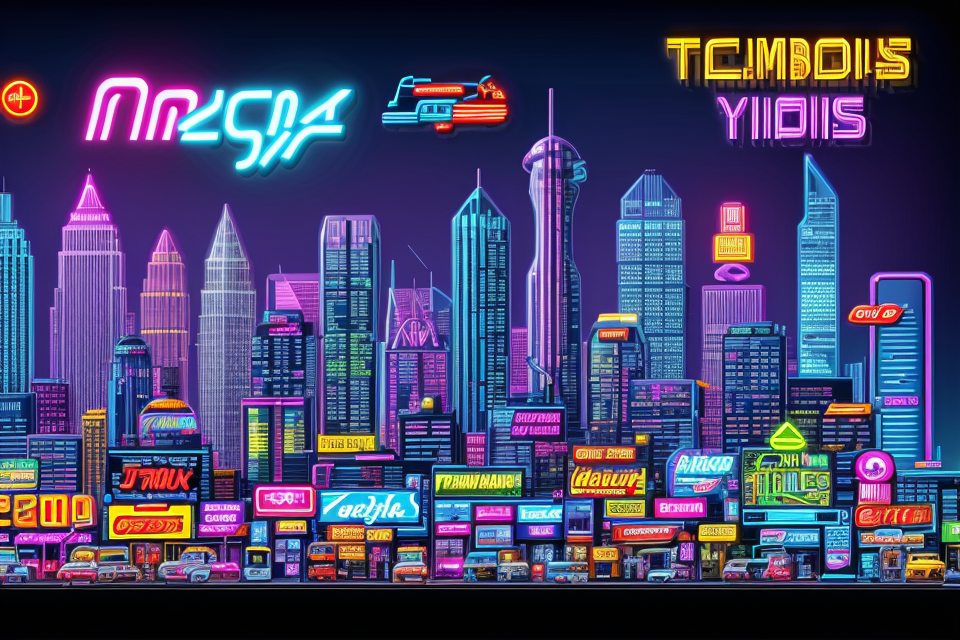Social media refers to online platforms and tools that allow users to create, share, and interact with content, information, and other users. These platforms have become an integral part of our daily lives, allowing us to connect with friends and family, share experiences, and stay informed about the world around us. However, understanding the concept of social media can be complex, with new platforms and features emerging constantly. This guide aims to provide a comprehensive overview of social media, explaining what it is, how it works, and why it matters. Whether you’re a seasoned social media user or just starting out, this guide will help you navigate the world of social media with confidence.
Definition of Social Media
- Social media refers to digital platforms and tools that facilitate the creation, sharing, and interaction with content, information, and other users.
- It encompasses a diverse array of activities, such as social networking, blogging, video sharing, and more.
- Social networking platforms enable users to connect with friends, family, and acquaintances, as well as form new relationships.
- Blogging platforms provide individuals with a space to share their thoughts, opinions, and experiences through written content.
- Video sharing platforms allow users to upload, share, and view video content, enabling the sharing of visual stories and experiences.
- Other forms of social media include image sharing, podcasting, and more, each with its own unique set of features and functions.
- Social media has become an integral part of modern communication and has significantly impacted the way people interact and engage with one another.
- It has transformed the way businesses market and communicate with their customers, enabling them to reach a wider audience and build stronger relationships.
- Social media has also become a powerful tool for activism, enabling individuals and groups to mobilize and raise awareness on important issues.
- However, it has also given rise to concerns about privacy, misinformation, and the potential for addiction and other negative effects.
- Overall, social media refers to a broad range of online platforms and tools that enable users to connect, create, and share content with others, and has become an integral part of modern communication and social interaction.
- It encompasses a diverse array of activities, such as social networking, blogging, video sharing, and more.
Types of Social Media
Social Networking Sites
Introduction to Social Networking Sites
Social networking sites are online platforms that allow users to create profiles, connect with others, and share content. These sites have become increasingly popular over the years, and they now play a significant role in how people communicate and interact with one another. Some of the most well-known social networking sites include Facebook, Twitter, LinkedIn, Instagram, and TikTok.
Features of Social Networking Sites
Social networking sites typically offer a range of features that enable users to connect with others and share content. These features may include:
- User profiles: Users can create profiles that include personal information, such as their name, age, location, and interests.
- News feeds: Users can view updates from their connections, such as status updates, photos, and videos.
- Messaging: Users can send private messages to their connections.
- Groups: Users can join groups based on shared interests or activities.
- Sharing: Users can share content, such as photos, videos, and links, with their connections.
Advantages and Disadvantages of Social Networking Sites
Like any technology, social networking sites have both advantages and disadvantages. Some of the advantages of these sites include:
- Connecting with others: Social networking sites allow users to connect with people they might not have had the opportunity to interact with otherwise.
- Sharing information: Users can share information and updates with their connections, which can help them stay informed about what’s going on in each other’s lives.
- Building communities: Social networking sites can be used to build communities around shared interests or activities.
However, there are also some disadvantages to using social networking sites. These include:
- Privacy concerns: Users may be concerned about the amount of personal information they are sharing on these sites.
- Cyberbullying: Social networking sites can be used as a platform for cyberbullying, which can have serious consequences for those who are targeted.
- Time management: Spending too much time on social networking sites can be detrimental to productivity and time management.
The Future of Social Networking Sites
As social networking sites continue to evolve, it’s likely that they will become even more integrated into our daily lives. It’s possible that we will see the emergence of new platforms that offer even more advanced features and capabilities. However, it’s also important to consider the potential risks and challenges associated with these sites, and to find ways to use them in a responsible and safe manner.
Blogging Platforms
Blogging platforms are a type of social media that allow users to create and share content in the form of written articles or blog posts. Some popular examples of blogging platforms include WordPress, Blogger, and Medium.
WordPress
WordPress is a free, open-source blogging platform that was first launched in 2003. It is now one of the most popular blogging platforms in the world, with over 60 million websites using it as their content management system. WordPress is known for its flexibility and customization options, making it a popular choice for both personal and business blogs.
Blogger
Blogger is a free blogging platform that was launched by Google in 1999. It is one of the oldest blogging platforms and is still in use today. Blogger is known for its simplicity and ease of use, making it a popular choice for beginners. It also has a range of templates and customization options available.
Medium
Medium is a blogging platform that was launched in 2012 by Twitter co-founder Ev Williams. It is a paid platform that offers a range of features for bloggers, including custom domains, advanced analytics, and the ability to monetize content through memberships and paywalls. Medium is known for its focus on high-quality content and its editorial team that curates and promotes the best articles on the platform.
Overall, blogging platforms provide users with a platform to share their thoughts, ideas, and experiences with a wider audience. They are a valuable tool for personal branding, marketing, and building an online community.
Video Sharing Platforms
Overview
Video sharing platforms are a type of social media that allow users to upload, share, and view videos online. These platforms have revolutionized the way people consume and share media, making it easier than ever to connect with others and access a wealth of content.
Popular Video Sharing Platforms
Some of the most popular video sharing platforms include:
- YouTube: With over 2 billion monthly active users, YouTube is the largest video sharing platform in the world. It allows users to upload and share videos on a wide range of topics, from music and comedy to educational content and documentaries.
- Vimeo: Vimeo is a smaller video sharing platform that is popular among filmmakers and creative professionals. It has a more user-friendly interface and a greater focus on high-quality content.
- Dailymotion: Dailymotion is a video sharing platform that is similar to YouTube, but with a smaller user base. It is popular in Europe and among niche communities.
Benefits and Drawbacks
Video sharing platforms offer many benefits, such as increased access to information and entertainment, and new opportunities for creators to reach a global audience. However, they also have some drawbacks, such as the potential for misinformation and the risk of copyright infringement.
In conclusion, video sharing platforms are an important part of the social media landscape, offering a unique way for people to connect and share content.
Photo Sharing Platforms
Photo sharing platforms are a type of social media that allow users to upload, share, and interact with digital images. These platforms provide a space for individuals to showcase their photography skills, share memories, and connect with others who have similar interests.
Some of the most popular photo sharing platforms include:
- Instagram: Instagram is a free, online photo and video sharing service that allows users to share their images and videos with others. It offers a range of editing tools, filters, and features that enable users to enhance their photos and make them more visually appealing.
- Flickr: Flickr is a photo sharing platform that offers a range of features, including a large storage capacity, photo organization tools, and the ability to share photos with others. It also has a strong community of photographers who share their work and provide feedback to one another.
- Pinterest: Pinterest is a social media platform that allows users to save and share images and videos they find online. It is particularly popular among individuals who enjoy DIY projects, fashion, and home decor. Users can create boards based on their interests and follow other users who share similar tastes.
Discussion Forums
Discussion forums are online platforms that allow users to engage in discussions, share information, and exchange ideas on various topics. They provide a space for people to interact with each other and express their opinions, making them an essential component of social media. Here are some of the most popular discussion forums:
Reddit is a vast network of online communities, known as subreddits, where users can discuss a wide range of topics. Subreddits cover everything from news and politics to hobbies and interests. Users can upvote and comment on posts, making Reddit a dynamic and engaging platform for discussion.
Quora
Quora is a question-and-answer platform where users can ask and answer questions on various topics. Quora allows users to follow topics and experts, making it easy to stay up-to-date on the latest discussions. Quora’s format encourages in-depth answers, making it a valuable resource for learning about different subjects.
Stack Exchange
Stack Exchange is a network of Q&A websites that cover a wide range of topics, including programming, web development, and technology. Each Stack Exchange site is dedicated to a specific topic, and users can ask and answer questions, earn reputation points, and participate in discussions. Stack Exchange sites have a strong community of experts and enthusiasts, making them valuable resources for knowledge and discussion.
How Social Media Works
User-Generated Content
Social media platforms rely heavily on user-generated content (UGC) to keep their users engaged and entertained. UGC refers to any content that is created and shared by users on social media platforms. This content can take many forms, including posts, photos, videos, and more.
Types of User-Generated Content
- Text posts: Short messages that users type and share with their followers. These can include updates on their personal lives, opinions on current events, or just random thoughts.
- Photos: Users can upload pictures that they have taken or found elsewhere. These photos can be of anything, from landscapes to food to pets.
- Videos: Users can record and share videos on social media platforms. These videos can be anything from funny clips to tutorials to vlogs.
- Reviews: Users can leave reviews of products or services they have used. These reviews can help other users make informed purchasing decisions.
- Memes: Memes are a type of UGC that have become very popular on social media. They are typically humorous images or videos with captions that are meant to be relatable or funny.
Why User-Generated Content Matters
UGC is important for social media platforms because it helps to create a sense of community and engagement among users. When users create and share content, they are contributing to the overall culture of the platform. This can help to foster a sense of belonging and connection among users.
Additionally, UGC can be a valuable source of content for social media platforms. By encouraging users to create and share content, social media platforms can keep their users engaged and entertained without having to rely solely on professionally produced content.
Overall, user-generated content is a key aspect of social media and plays a crucial role in shaping the culture and community of each platform.
Networking and Communication
One of the primary functions of social media is to facilitate networking and communication among its users. This section will explore how social media platforms enable users to connect with others and engage in various forms of communication.
Public Profiles
Social media platforms allow users to create public profiles that contain personal information, such as their name, age, location, and interests. These profiles serve as a digital identity that other users can search for and view. Users can also share content, such as photos and videos, on their profiles, which can be seen by their followers or the general public.
Private Messaging
In addition to public profiles, social media platforms also offer private messaging features that allow users to communicate directly with each other. Users can send private messages to individuals or groups, and these messages are typically encrypted to ensure privacy. Private messaging can be used for a variety of purposes, such as personal communication, business transactions, or confidential discussions.
Groups and Communities
Social media platforms also provide users with the ability to join groups and communities based on shared interests or goals. These groups can range from small, closed communities to large, public groups with thousands of members. Users can participate in group discussions, share content, and collaborate on projects with other members. Groups and communities can also serve as a platform for social activism, where users can organize and mobilize around a common cause.
Overall, the networking and communication features of social media platforms have revolutionized the way people connect and interact with each other. Whether it’s through public profiles, private messaging, or group participation, social media has made it easier than ever for people to connect and collaborate with others from all over the world.
Advertising and Monetization
Social media platforms generate revenue primarily through advertising and sponsored content. Advertisers pay to display their ads on the platform, targeting specific audiences based on their demographics, interests, and behaviors. These ads can take various forms, such as display ads, video ads, sponsored posts, and influencer marketing.
Moreover, some social media platforms allow users to monetize their own content through partnerships and sponsorships. This can include sponsored posts, product reviews, and affiliate marketing. For example, a social media influencer with a large following may partner with a brand to promote their products or services, earning a commission for each sale or engagement generated through their posts.
Additionally, some social media platforms offer paid tools and services, such as premium accounts, analytics, and advertising services, to businesses and individuals looking to boost their online presence and reach. These services can help users to better understand their audience, optimize their content, and measure their performance on the platform.
Overall, advertising and monetization play a significant role in the revenue model of social media platforms, providing opportunities for both the platforms themselves and individual users to generate income from their online activities.
Benefits and Drawbacks of Social Media
Benefits
- Increased connectivity and communication
- Enhanced marketing and advertising opportunities
- Improved access to information and knowledge
Increased Connectivity and Communication
Social media platforms provide individuals with the ability to connect and communicate with others in ways that were previously not possible. With the click of a button, users can send messages, share photos and videos, and connect with people from all over the world. This increased connectivity has enabled people to build relationships, network, and collaborate on a global scale.
Enhanced Marketing and Advertising Opportunities
Social media has revolutionized the way businesses market and advertise their products and services. With the ability to target specific audiences, businesses can reach a larger and more relevant audience than ever before. Social media platforms also provide businesses with the ability to collect data on their customers, which can be used to improve marketing strategies and increase sales.
Improved Access to Information and Knowledge
Social media has become a powerful tool for disseminating information and knowledge. With the ability to share information quickly and easily, social media has enabled individuals to access a wealth of information on a wide range of topics. This has led to an increase in education and awareness on important issues, as well as the democratization of information.
Drawbacks
- Privacy concerns and data security issues
- Social media platforms collect and store large amounts of personal data, including users’ location, interests, and online activity. This data can be accessed by advertisers and other third parties, leading to privacy concerns.
- Users may also be at risk of identity theft and other security breaches, as their personal information can be easily accessed by malicious actors.
- Addiction and time management issues
- Social media can be addictive, and users may spend excessive amounts of time scrolling through their feeds, which can negatively impact their productivity and ability to focus on other tasks.
- Social media platforms often use algorithms that are designed to keep users engaged, which can contribute to addiction and make it difficult for users to disengage from the platform.
- Cyberbullying and online harassment
- Social media provides a platform for individuals to engage in cyberbullying and online harassment, which can have serious consequences for the victim’s mental health and well-being.
- Cyberbullying can take many forms, including online harassment, threats, and the spreading of rumors or false information.
- Social media platforms have faced criticism for not doing enough to prevent cyberbullying and online harassment on their platforms, leading to concerns about user safety and well-being.
The Future of Social Media
Emerging Trends
As social media continues to evolve, there are several emerging trends that are likely to shape its future. Some of these trends include:
Virtual reality and augmented reality integration
Virtual reality (VR) and augmented reality (AR) are two technologies that are increasingly being integrated into social media platforms. This integration is allowing users to experience social media in new and more immersive ways. For example, VR can be used to create virtual events, while AR can be used to add interactive elements to social media posts.
Increased use of artificial intelligence and machine learning
Artificial intelligence (AI) and machine learning (ML) are becoming more prevalent in social media, with platforms using these technologies to improve user experiences and increase efficiency. For example, AI can be used to personalize content recommendations, while ML can be used to identify and remove harmful content.
Greater emphasis on privacy and data security
As concerns over data privacy and security continue to grow, social media platforms are increasingly emphasizing these issues. This includes implementing stricter data protection policies, as well as providing users with more control over their personal data. Additionally, some platforms are exploring ways to use blockchain technology to improve data security and privacy.
Potential Challenges
- Regulation and censorship concerns
Social media platforms face the challenge of balancing free speech with the need for regulation. Governments around the world are increasingly seeking to regulate social media content, particularly in areas such as hate speech, misinformation, and extremist content. This can be a difficult balancing act, as over-regulation can stifle innovation and free expression, while under-regulation can lead to the spread of harmful content. - Ethical considerations for user data and privacy
As social media platforms collect more and more data on their users, there are growing concerns about how this data is being used and protected. There have been several high-profile data breaches in recent years, which have raised questions about the security of user data. Additionally, there are concerns about how user data is being used by social media companies for targeted advertising and other purposes. This has led to increased scrutiny of data collection practices and a push for greater transparency and user control over their own data. - The impact of social media on mental health and well-being
Social media has been linked to a range of negative effects on mental health, including increased rates of depression, anxiety, and loneliness. Some of the factors contributing to these negative effects include the constant comparison to others, the pressure to maintain an online persona, and the prevalence of cyberbullying and online harassment. Additionally, the use of social media can be addictive, leading to decreased sleep and increased stress levels. As social media continues to play an increasingly prominent role in our lives, it is important to consider the potential impacts on our mental health and well-being.
FAQs
1. What is social media?
Social media refers to online platforms and tools that allow users to create, share, and interact with content, information, and other users. Social media platforms include popular websites and apps like Facebook, Twitter, Instagram, LinkedIn, and many others. These platforms enable users to connect with friends and family, share updates and photos, and join online communities based on shared interests and hobbies.
2. What are the benefits of using social media?
There are many benefits to using social media, including staying connected with friends and family, sharing updates and photos, and connecting with others who share similar interests and hobbies. Social media can also be a powerful tool for businesses, allowing them to reach new customers, build brand awareness, and engage with their audience. Additionally, social media can provide access to a wealth of information and news, as well as opportunities for education and professional development.
3. How do I get started with social media?
Getting started with social media is easy! All you need is an internet connection and a device like a computer, smartphone, or tablet. To start, simply choose a social media platform that you’re interested in, such as Facebook or Twitter, and create an account. Many social media platforms will ask for basic information like your name and email address, and may also require a password. Once you’ve created an account, you can start exploring the platform and connecting with others.
4. How do I use social media effectively?
Using social media effectively requires a few key strategies. First, it’s important to identify your goals for using social media, whether that’s staying connected with friends and family, building your business, or sharing information and news. Next, choose a few social media platforms that align with your goals and interests, and make sure to engage with others regularly. This can include posting updates, sharing interesting content, and responding to comments and messages. Finally, be mindful of your online presence and how you represent yourself on social media.
5. Is social media safe to use?
Like any online platform, social media can present certain risks and challenges. It’s important to be mindful of your online privacy and security, and to be cautious when sharing personal information. Additionally, social media platforms may collect and use your data for advertising and other purposes, so it’s important to review and understand the privacy policies of the platforms you use. However, when used responsibly and with awareness, social media can be a valuable and safe tool for staying connected and sharing information.



